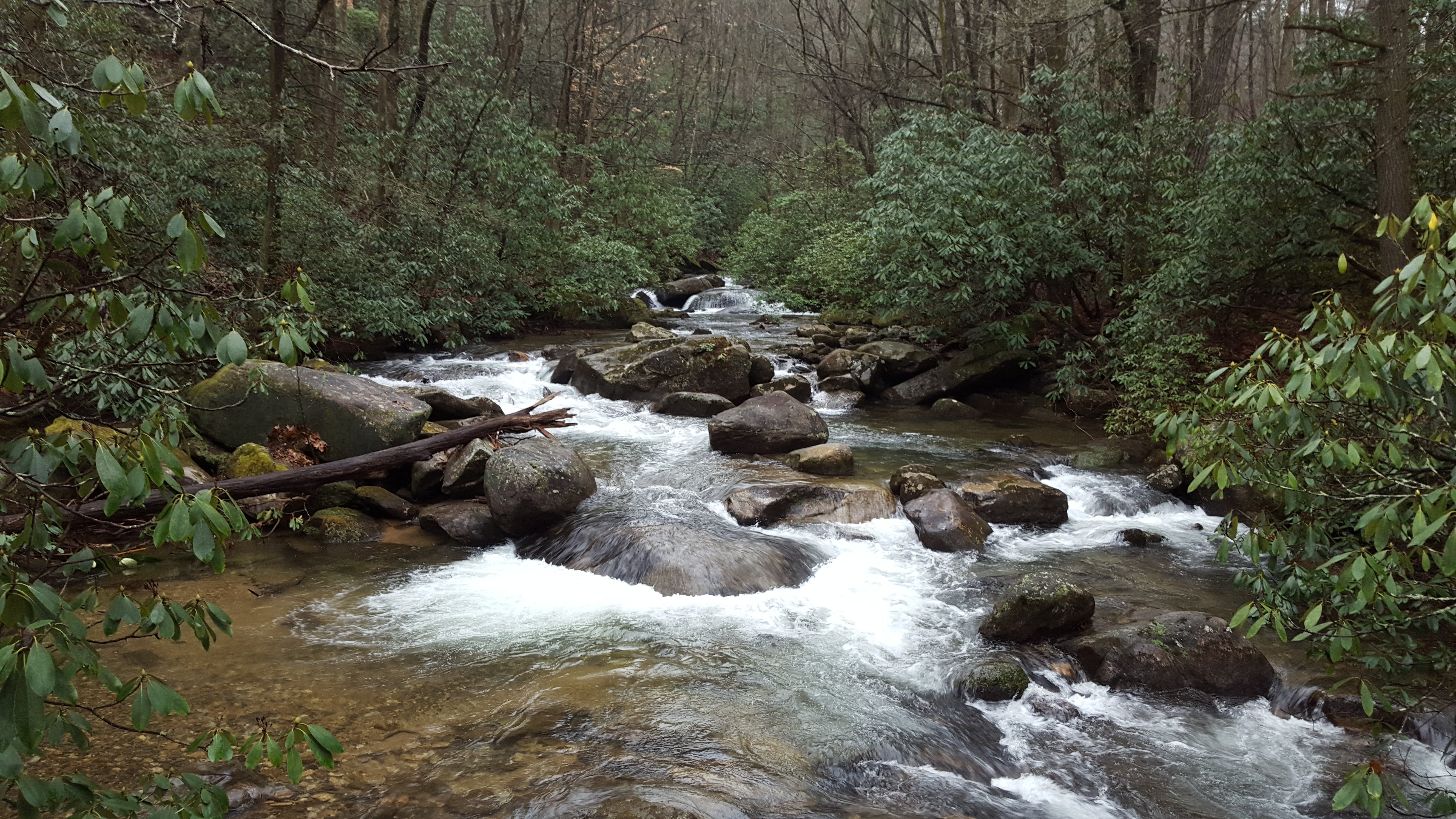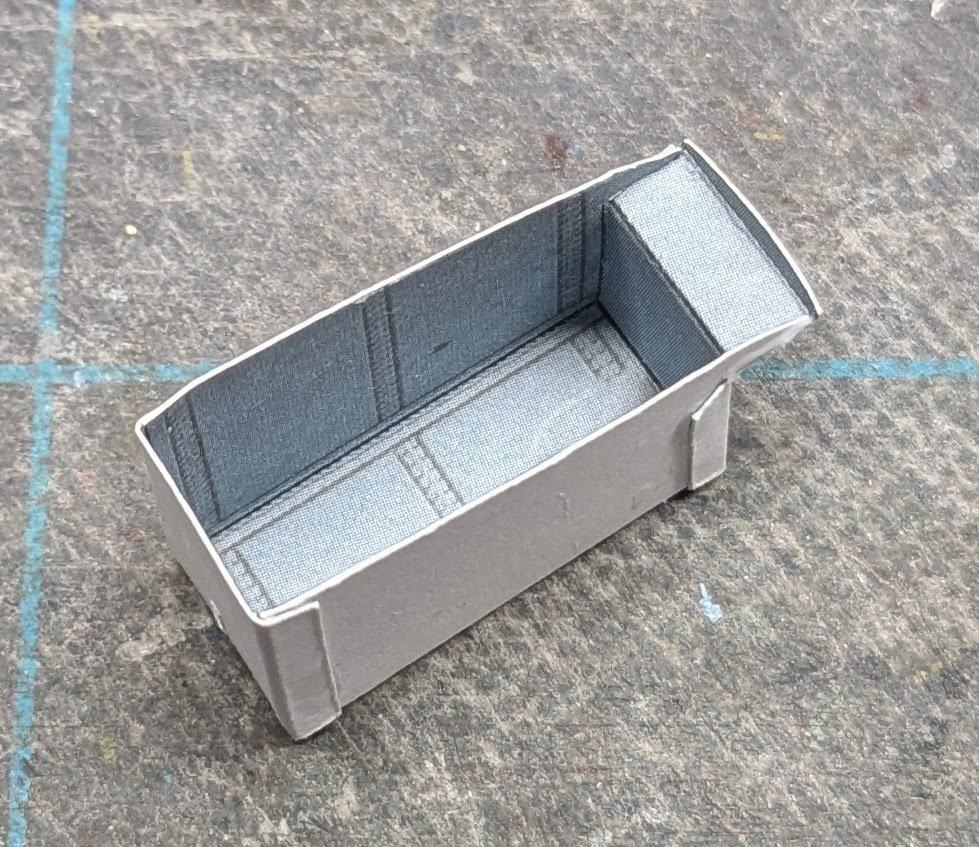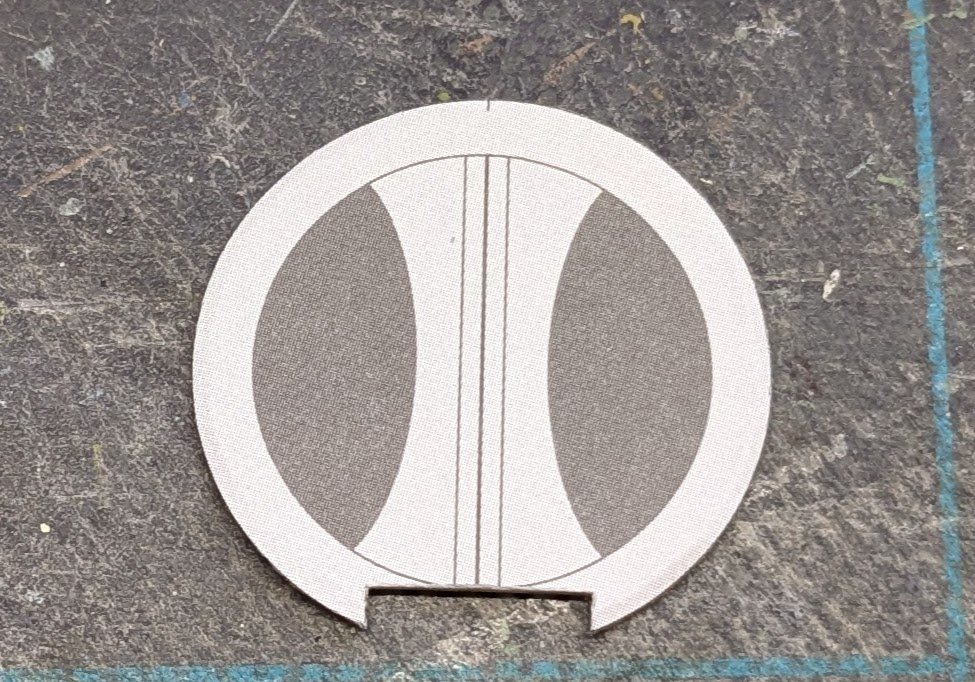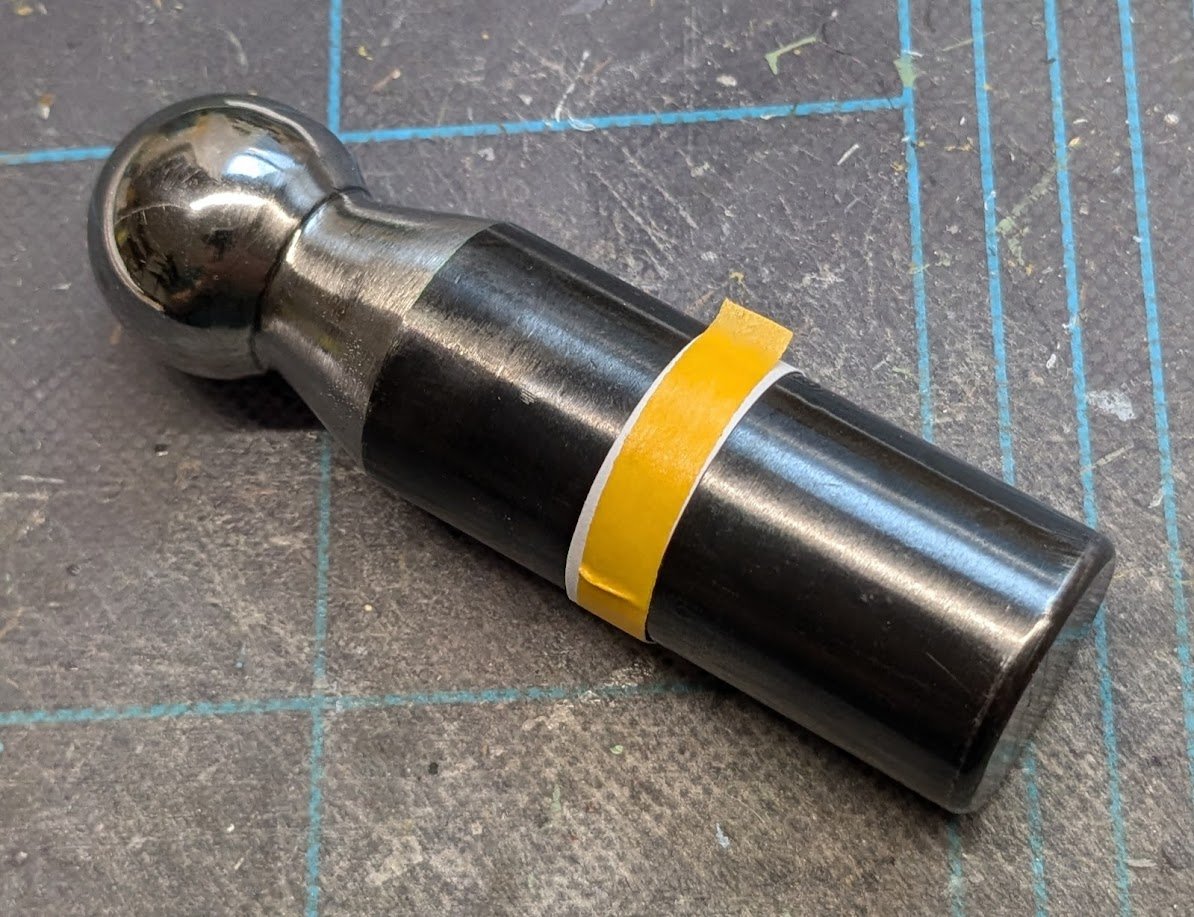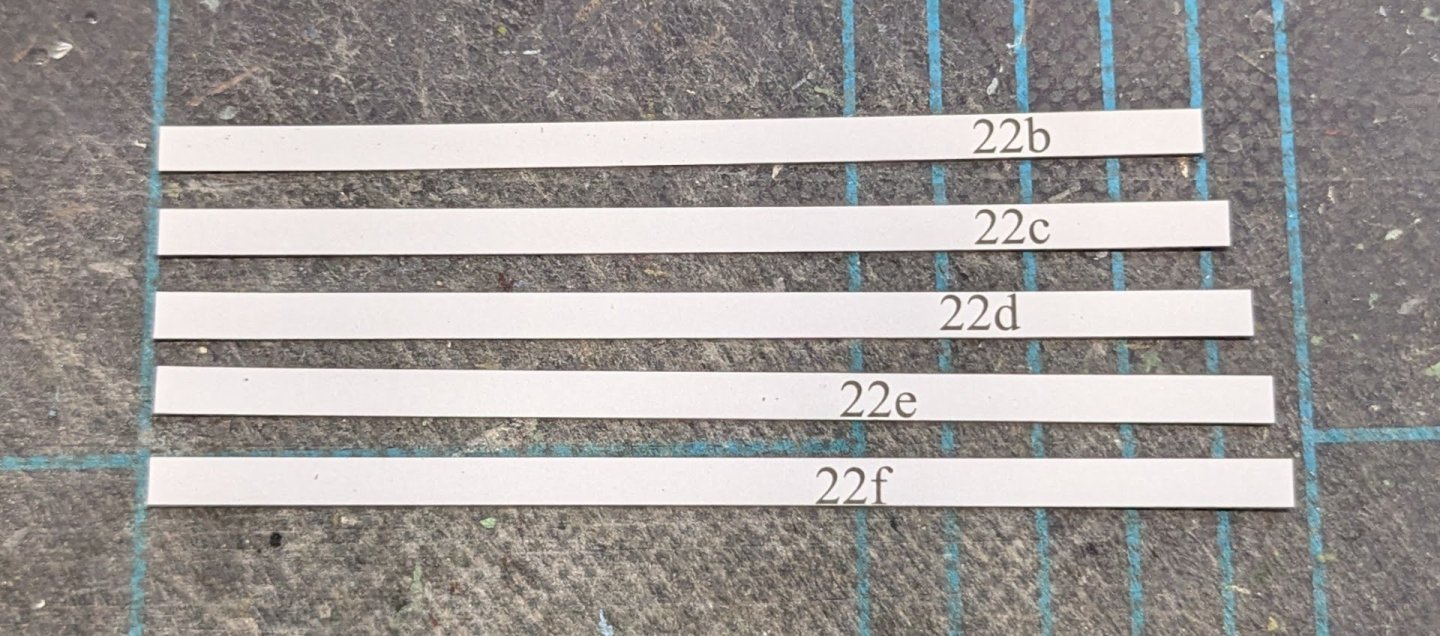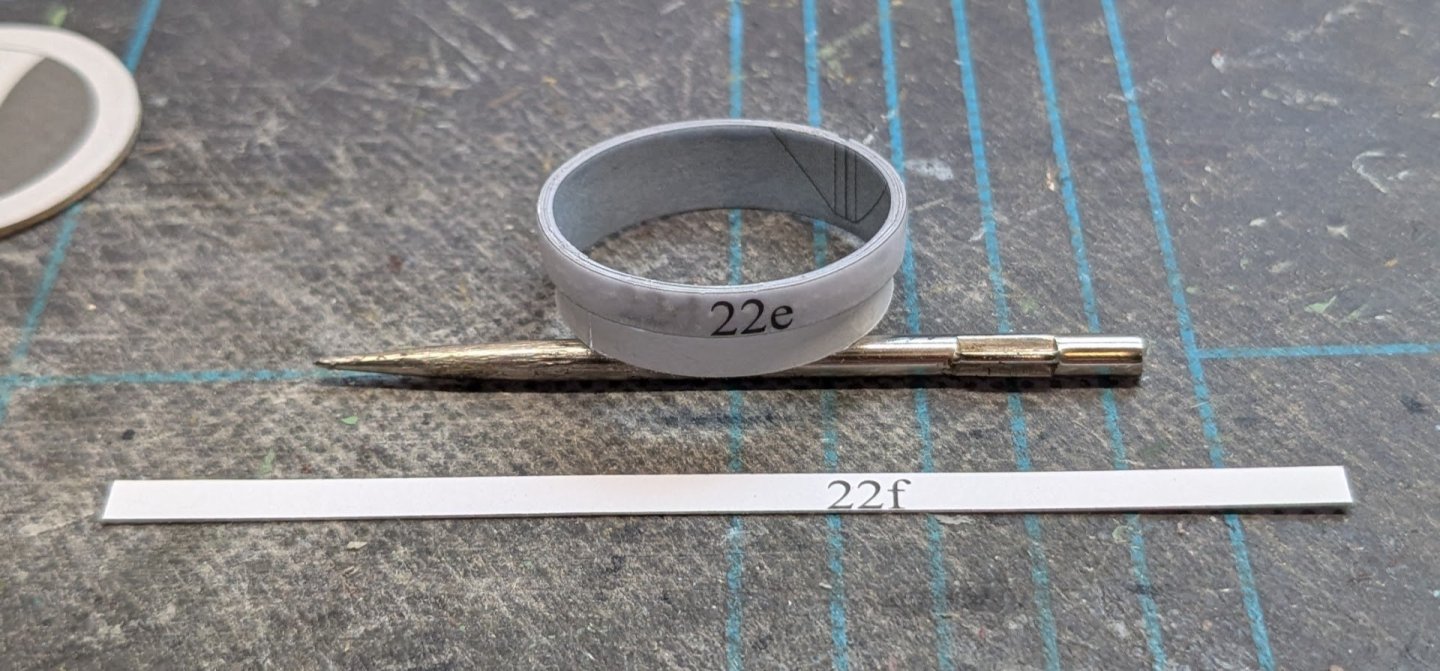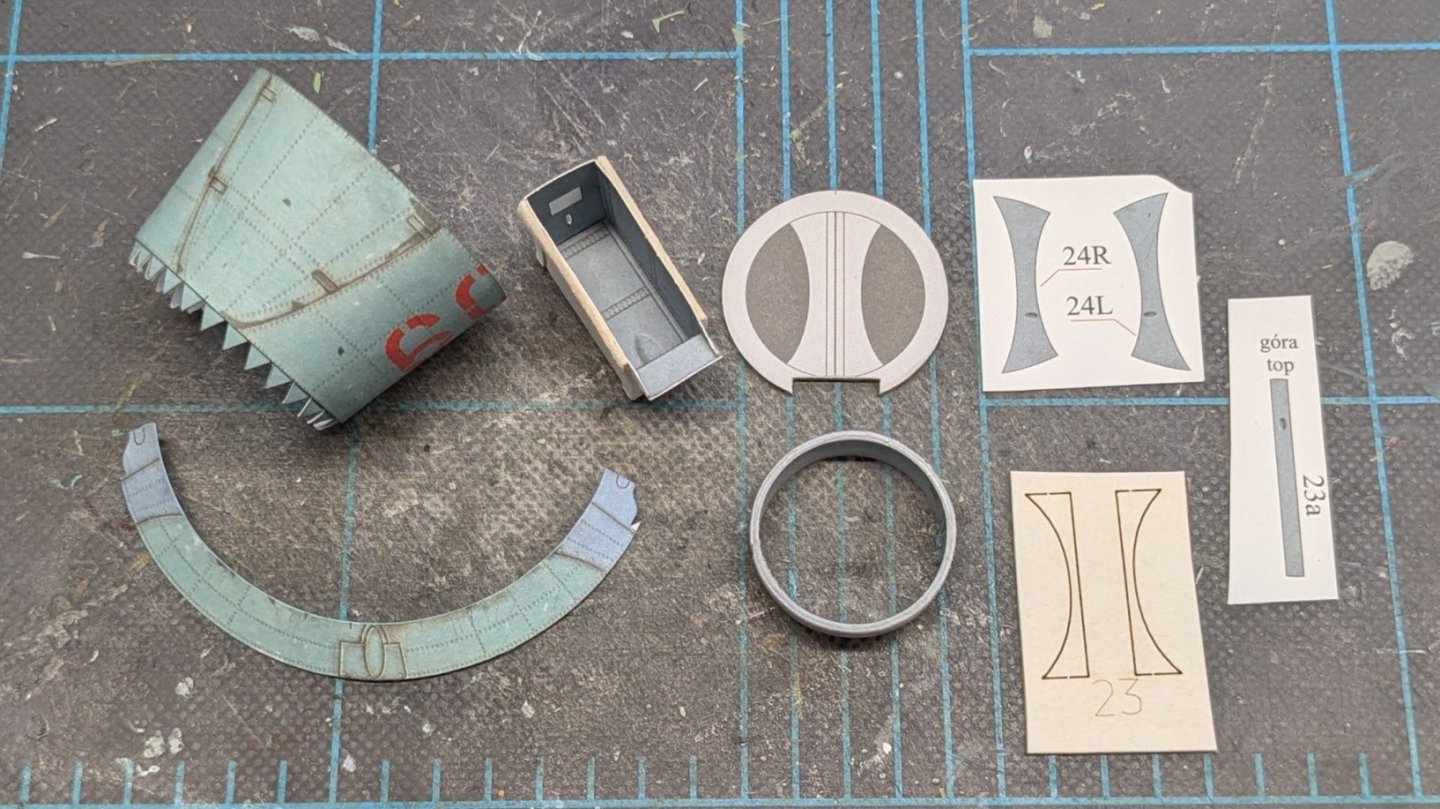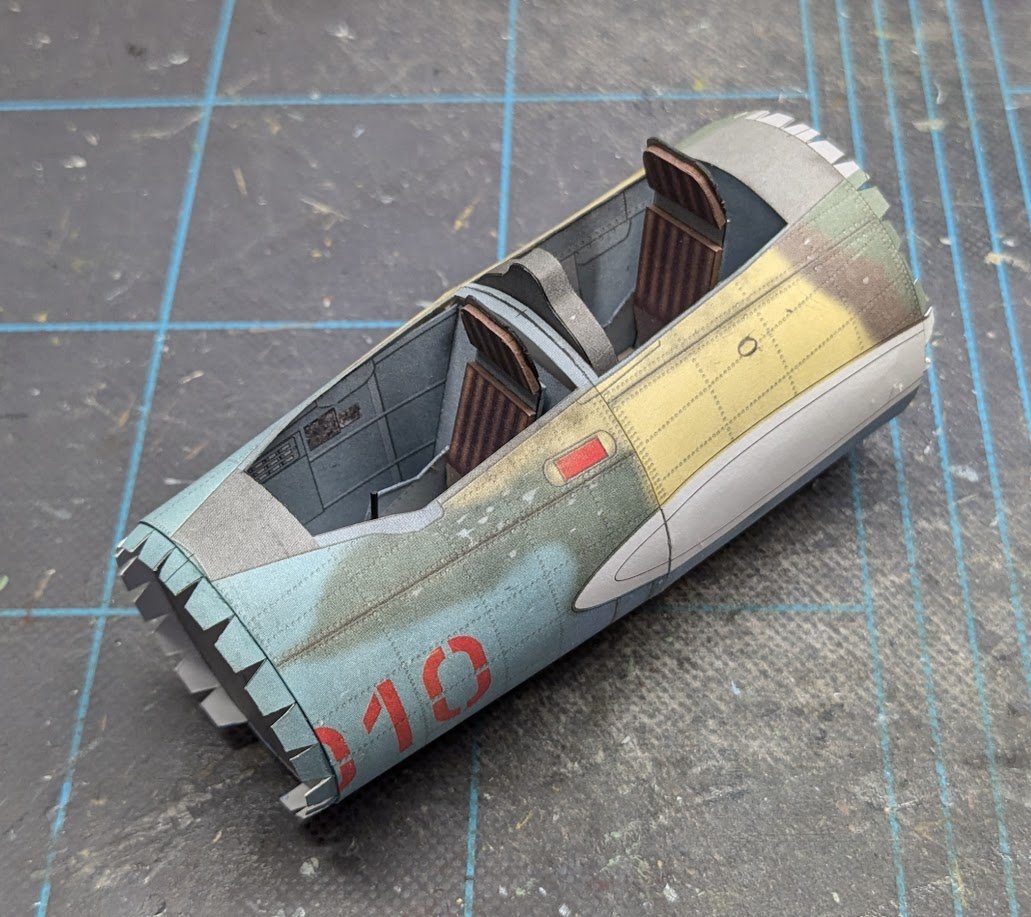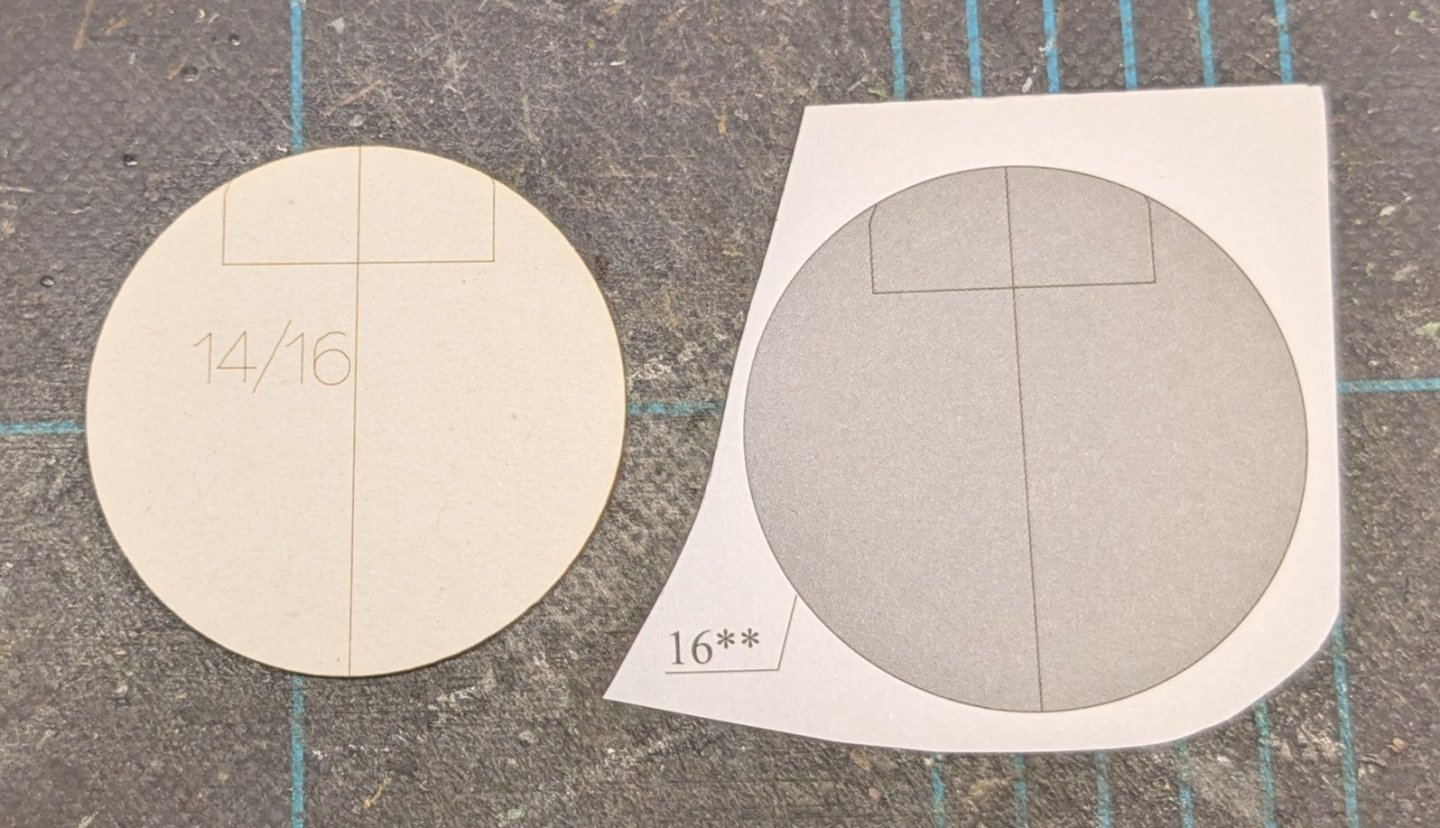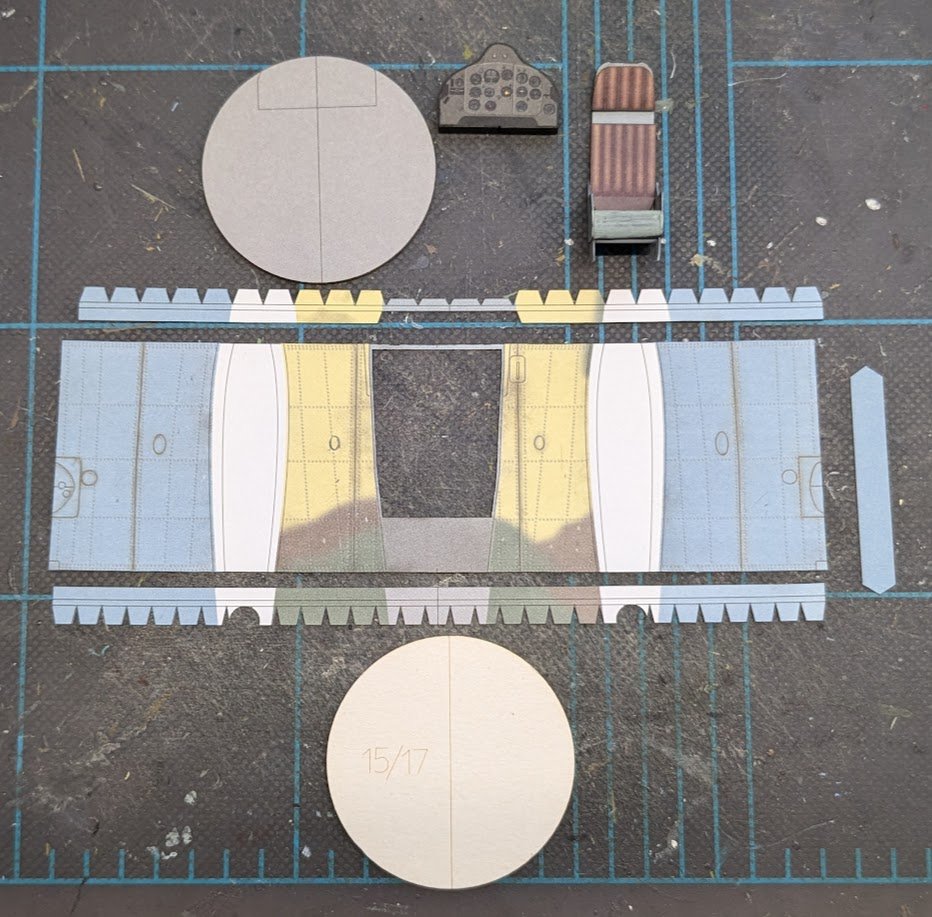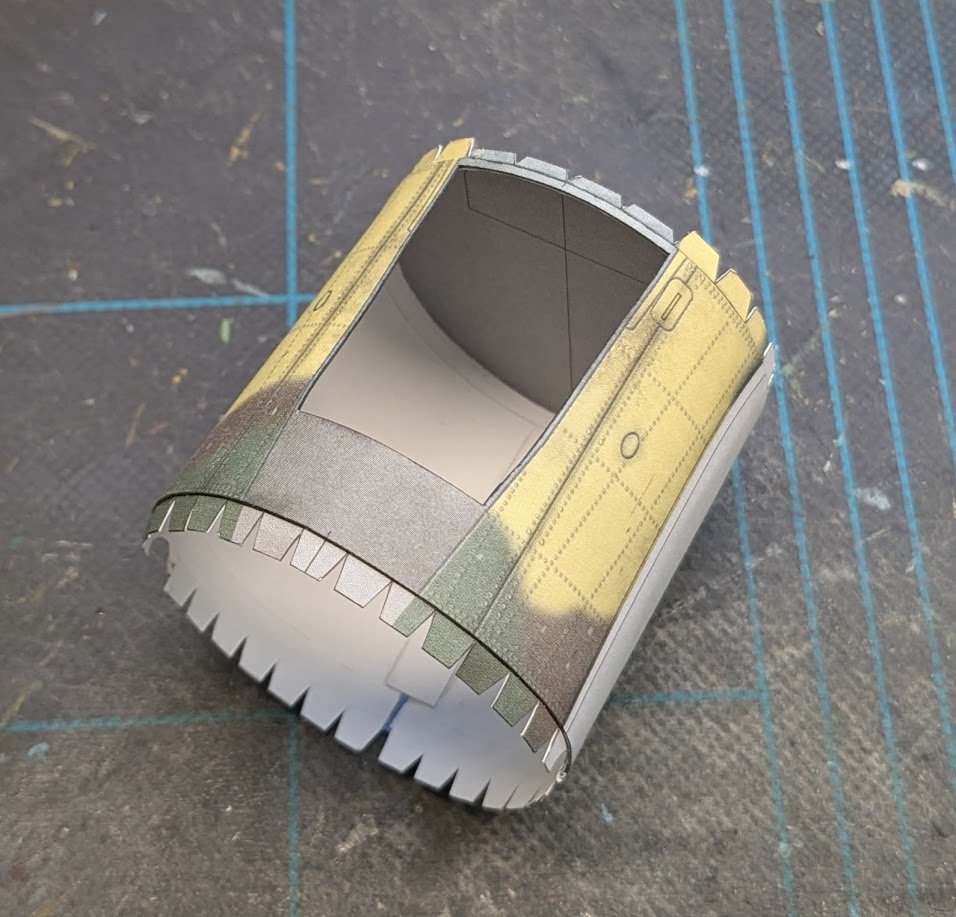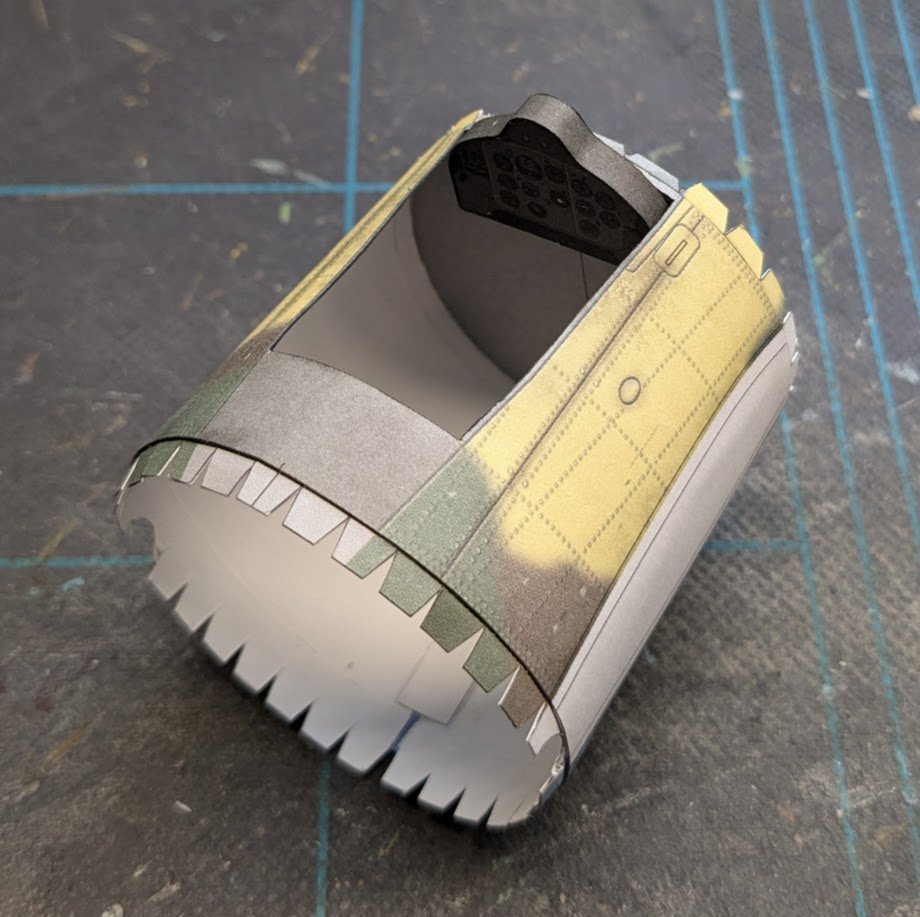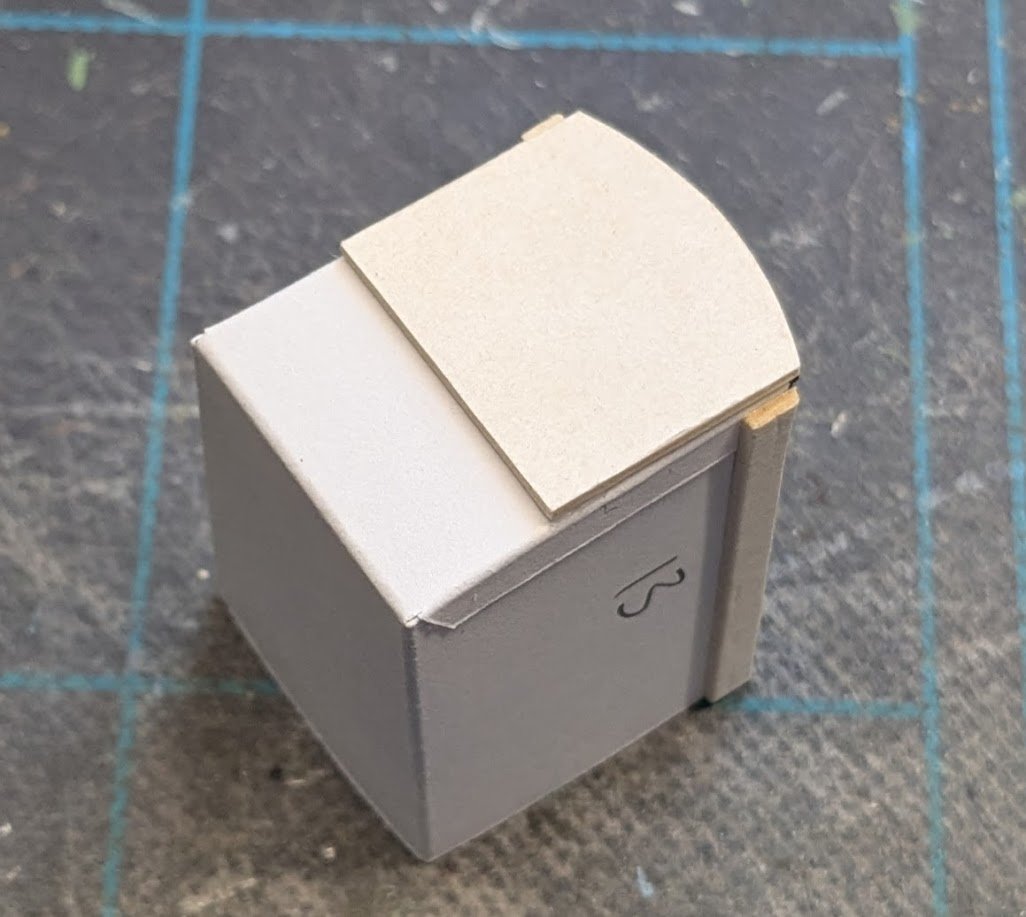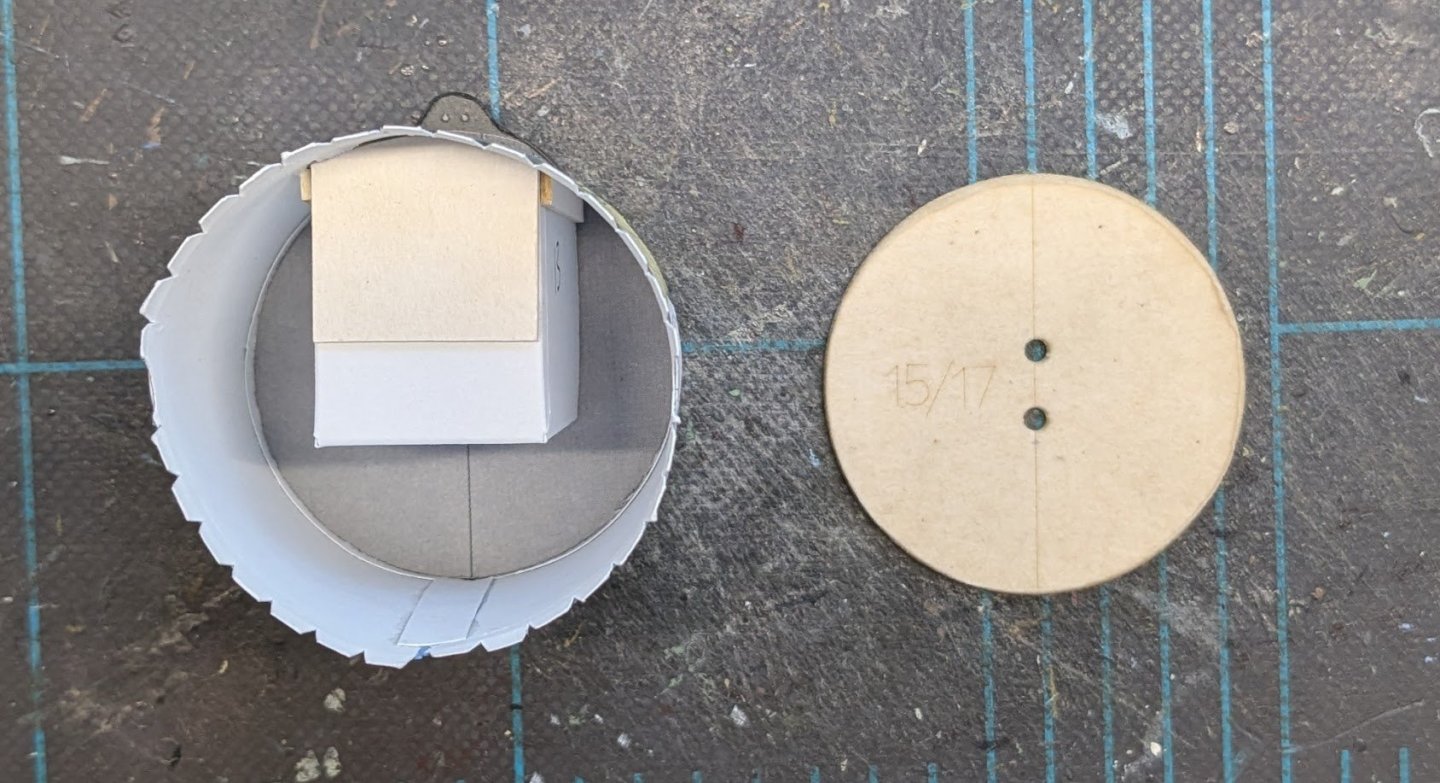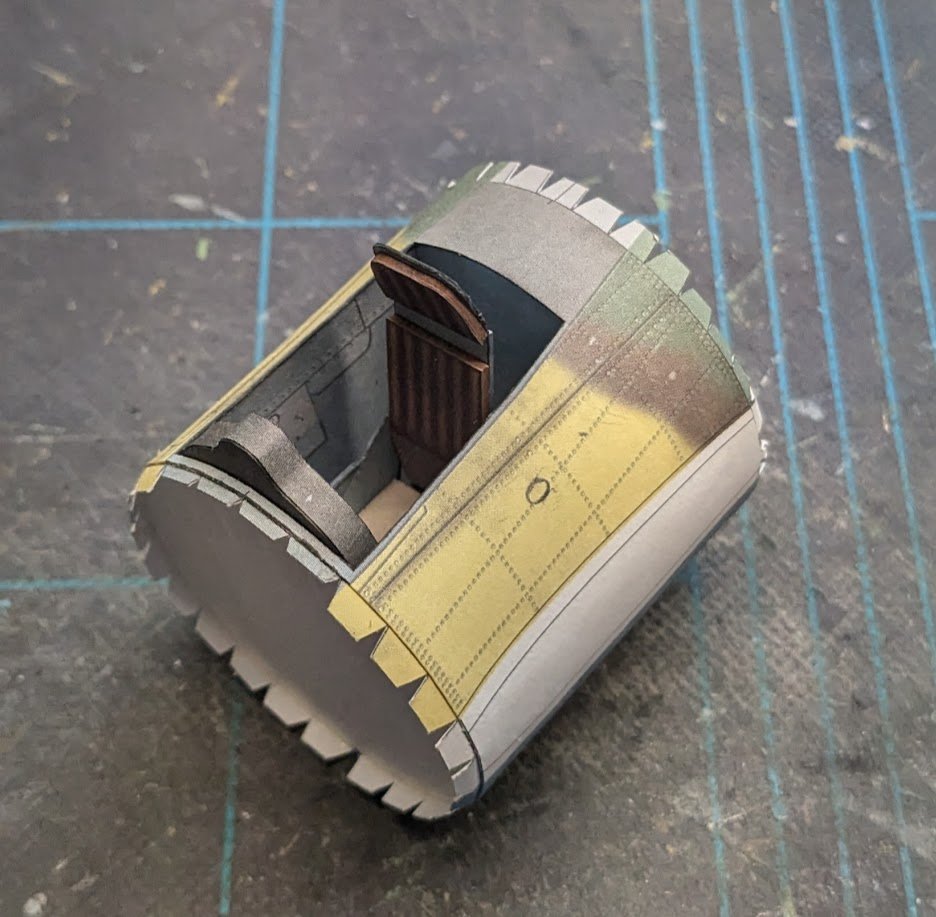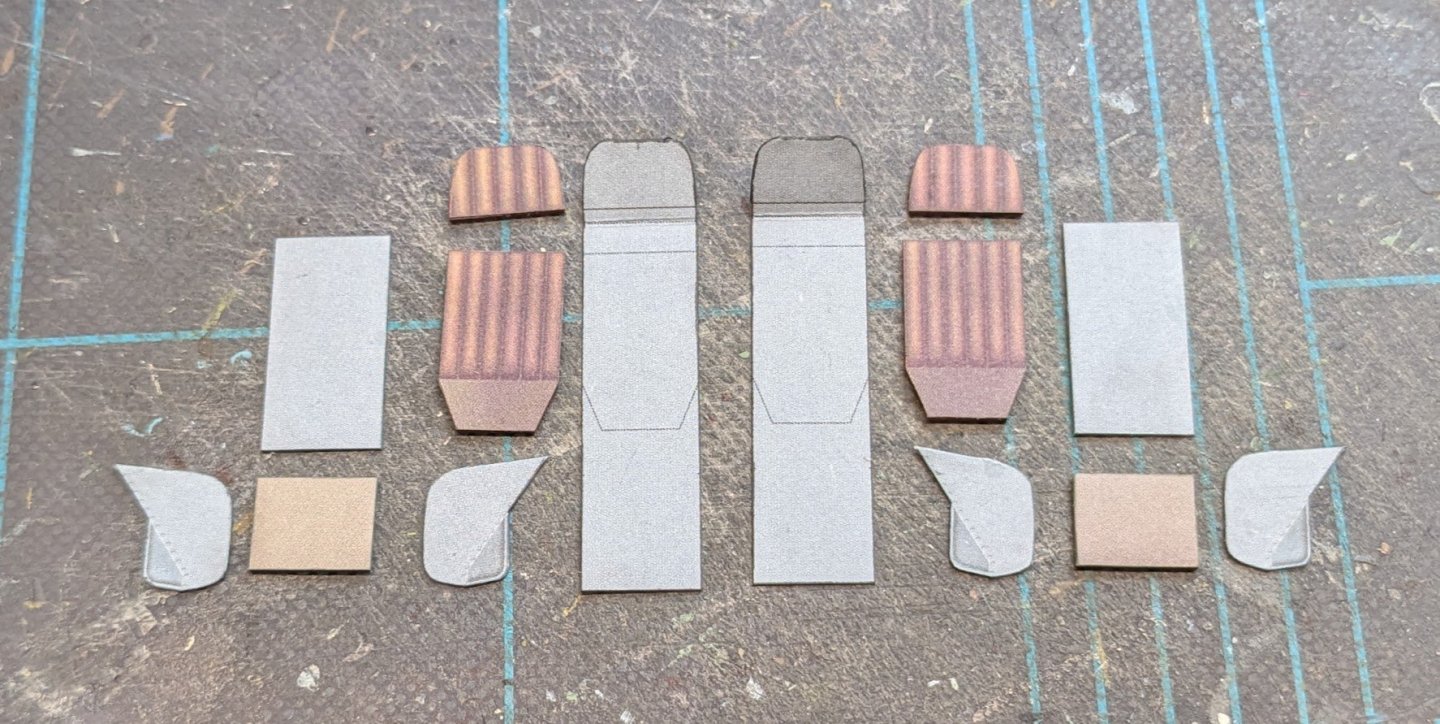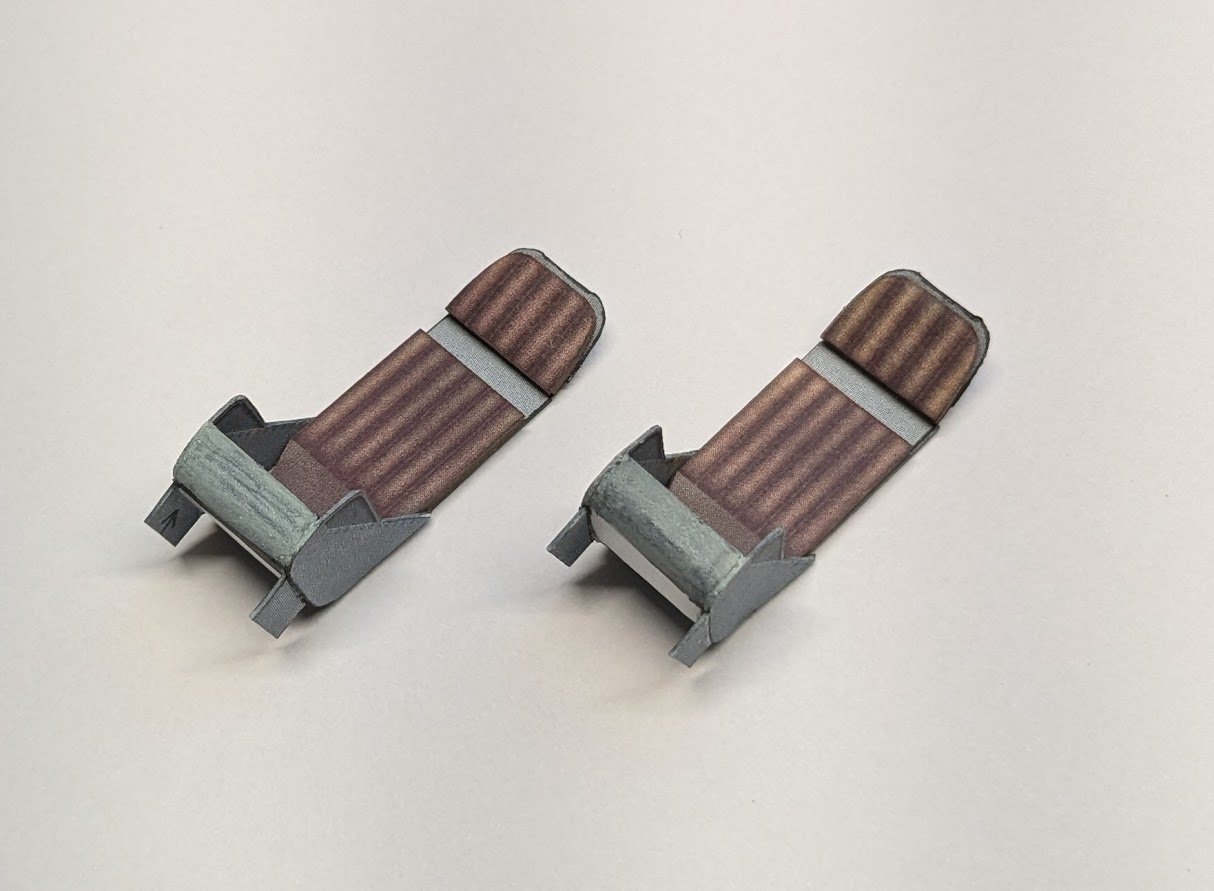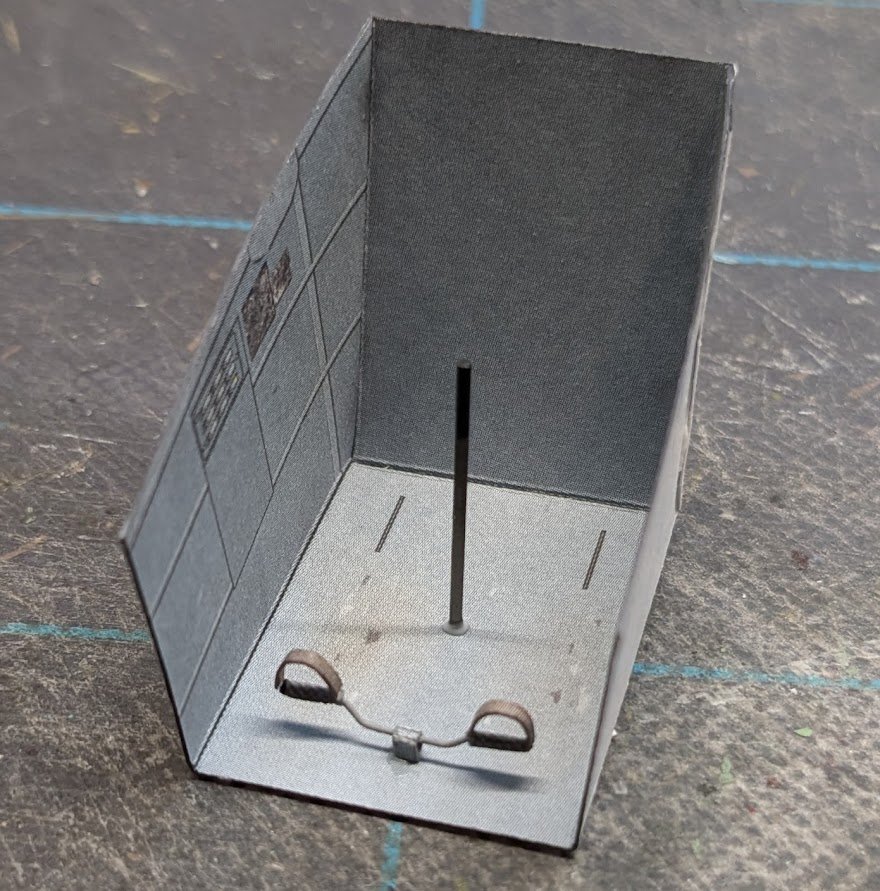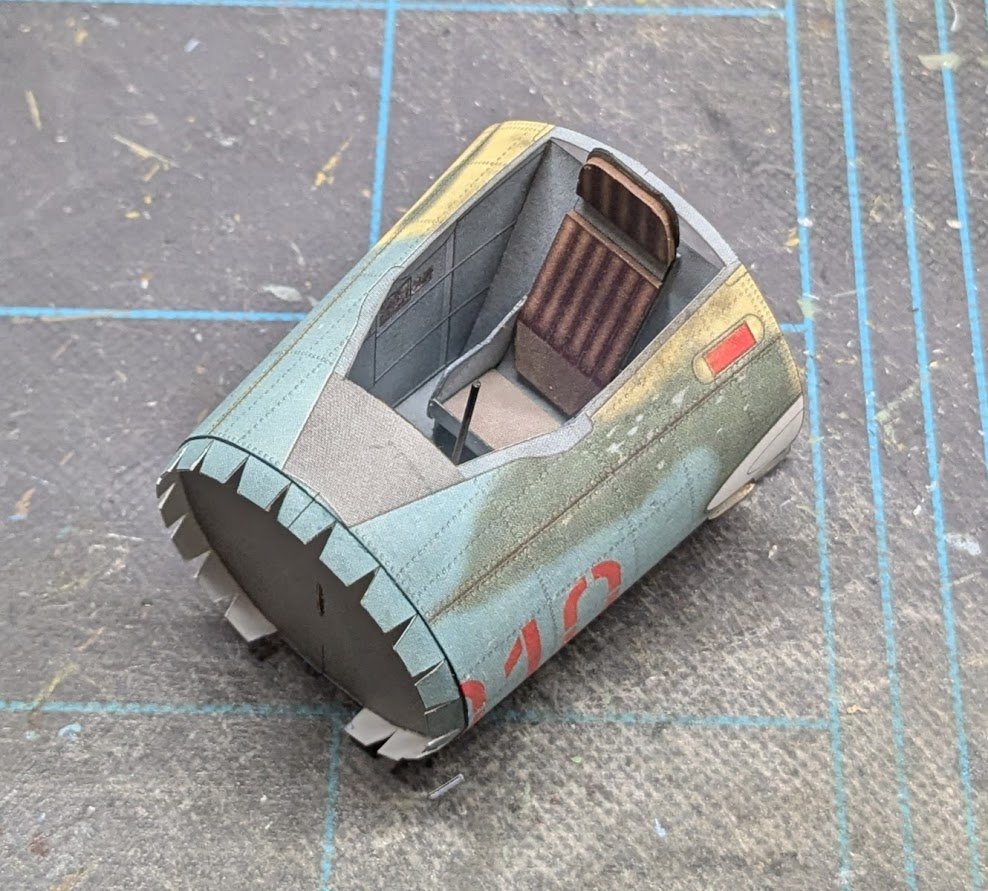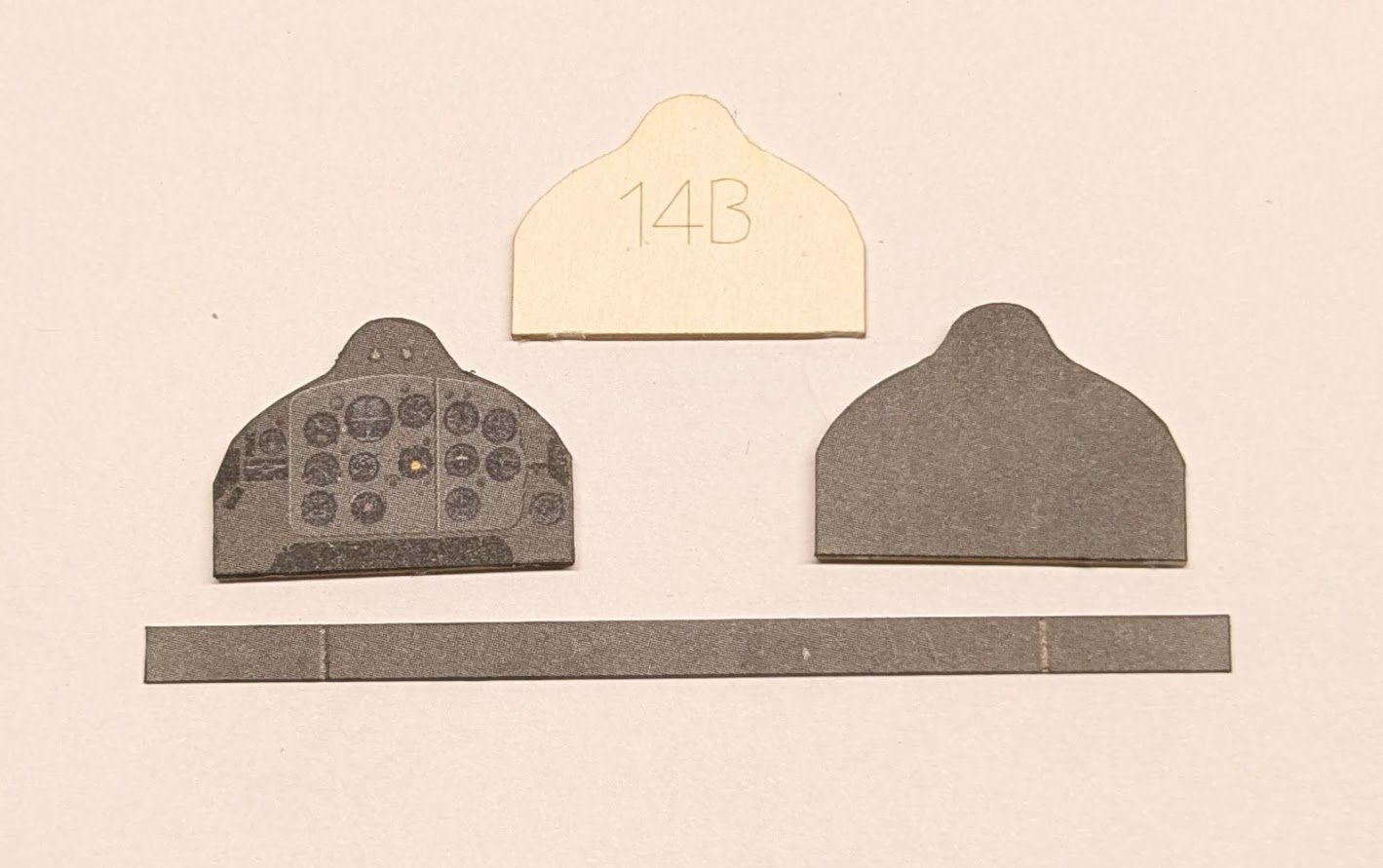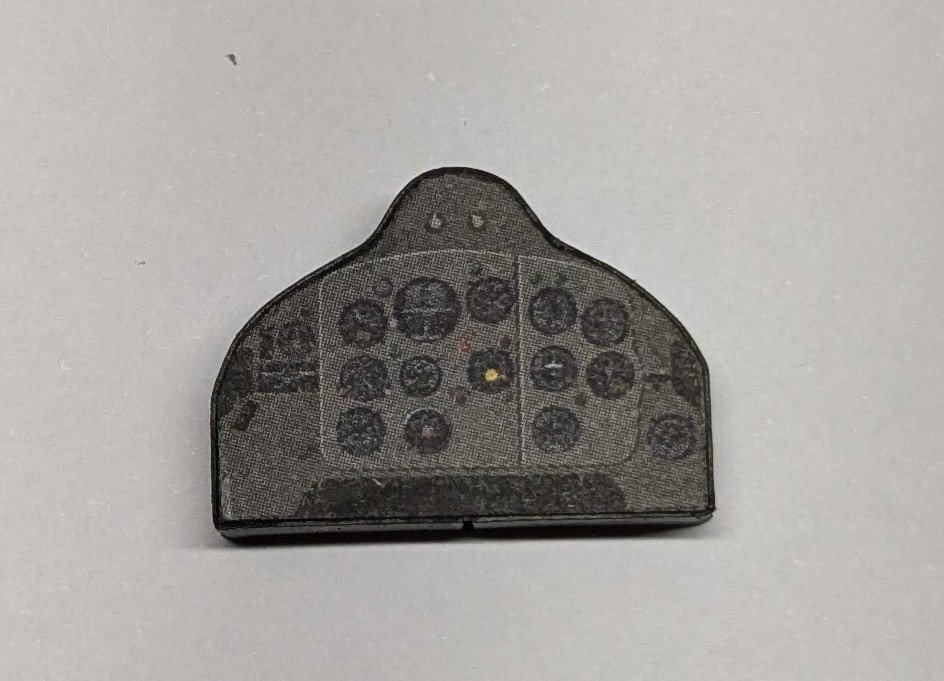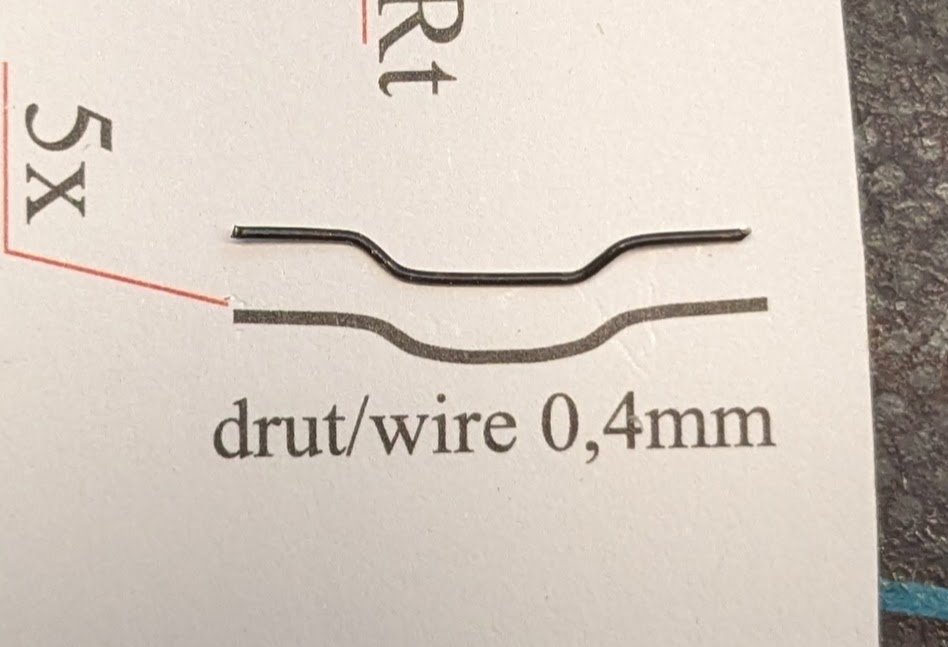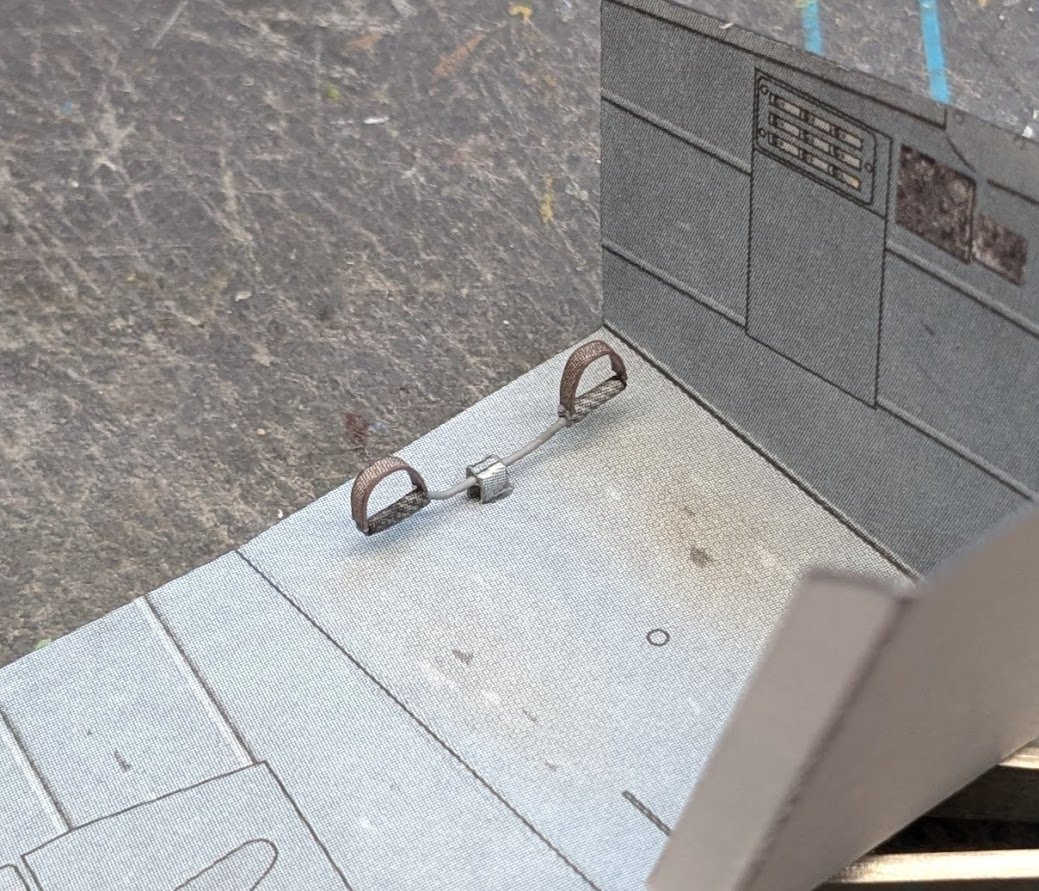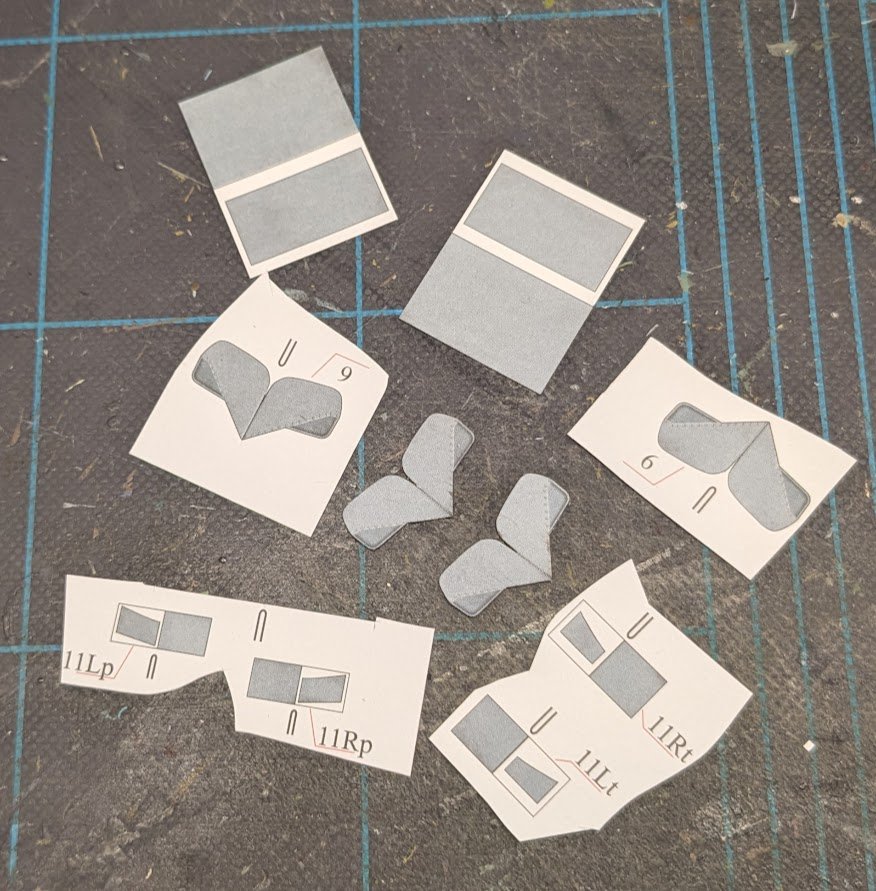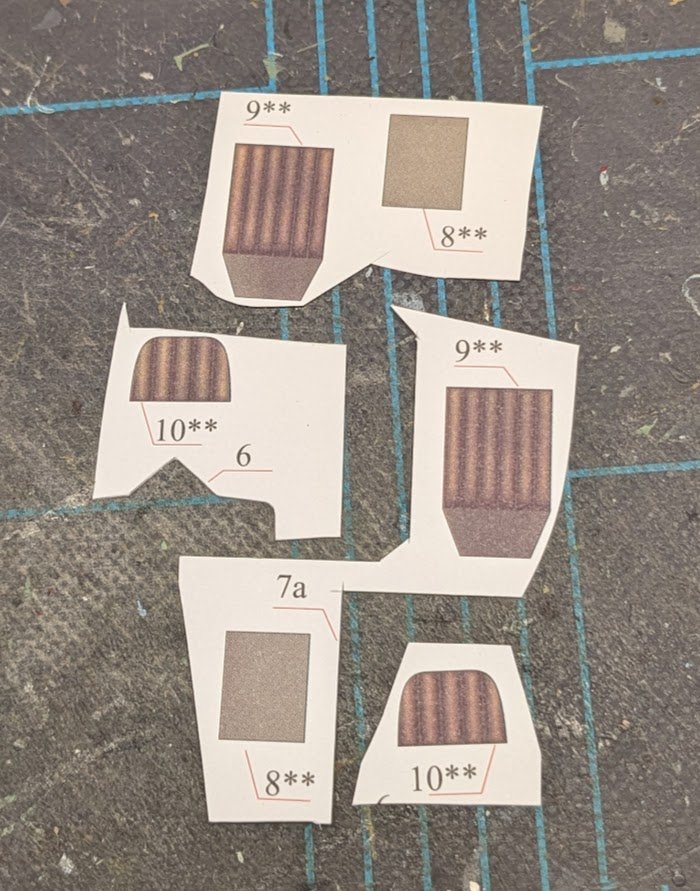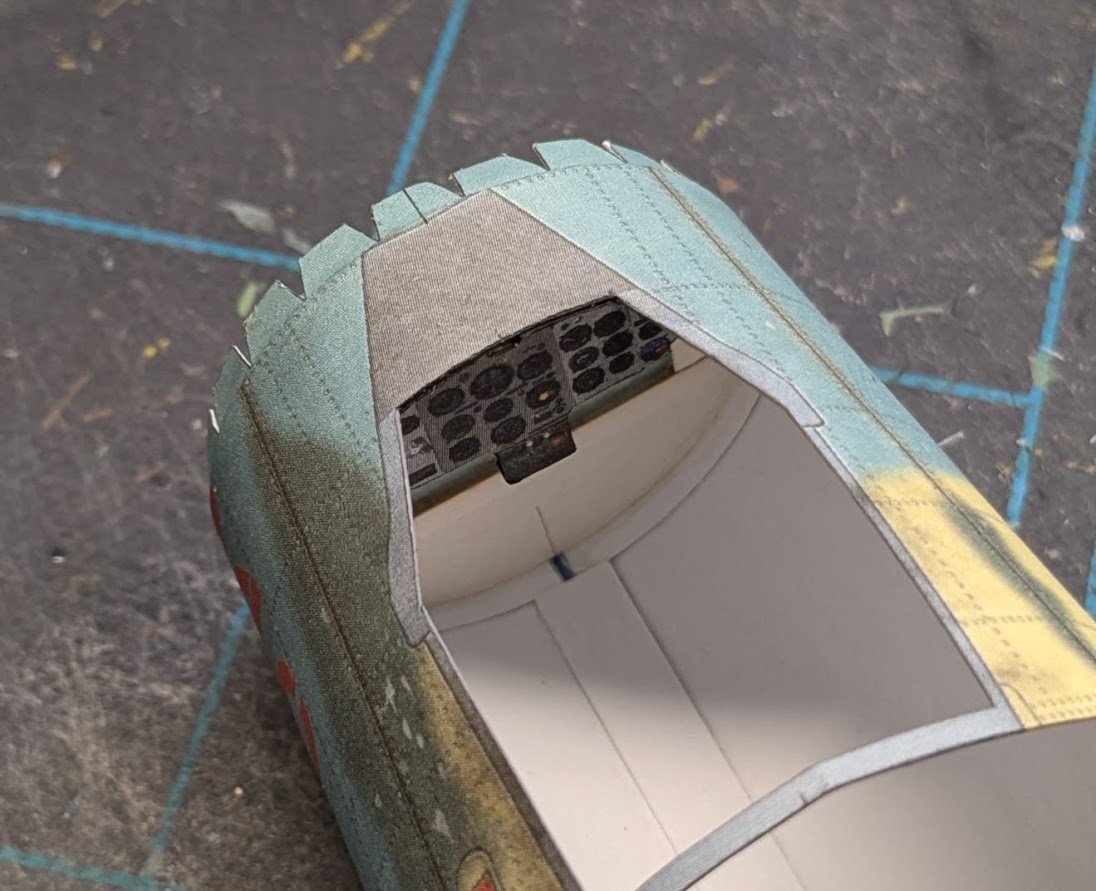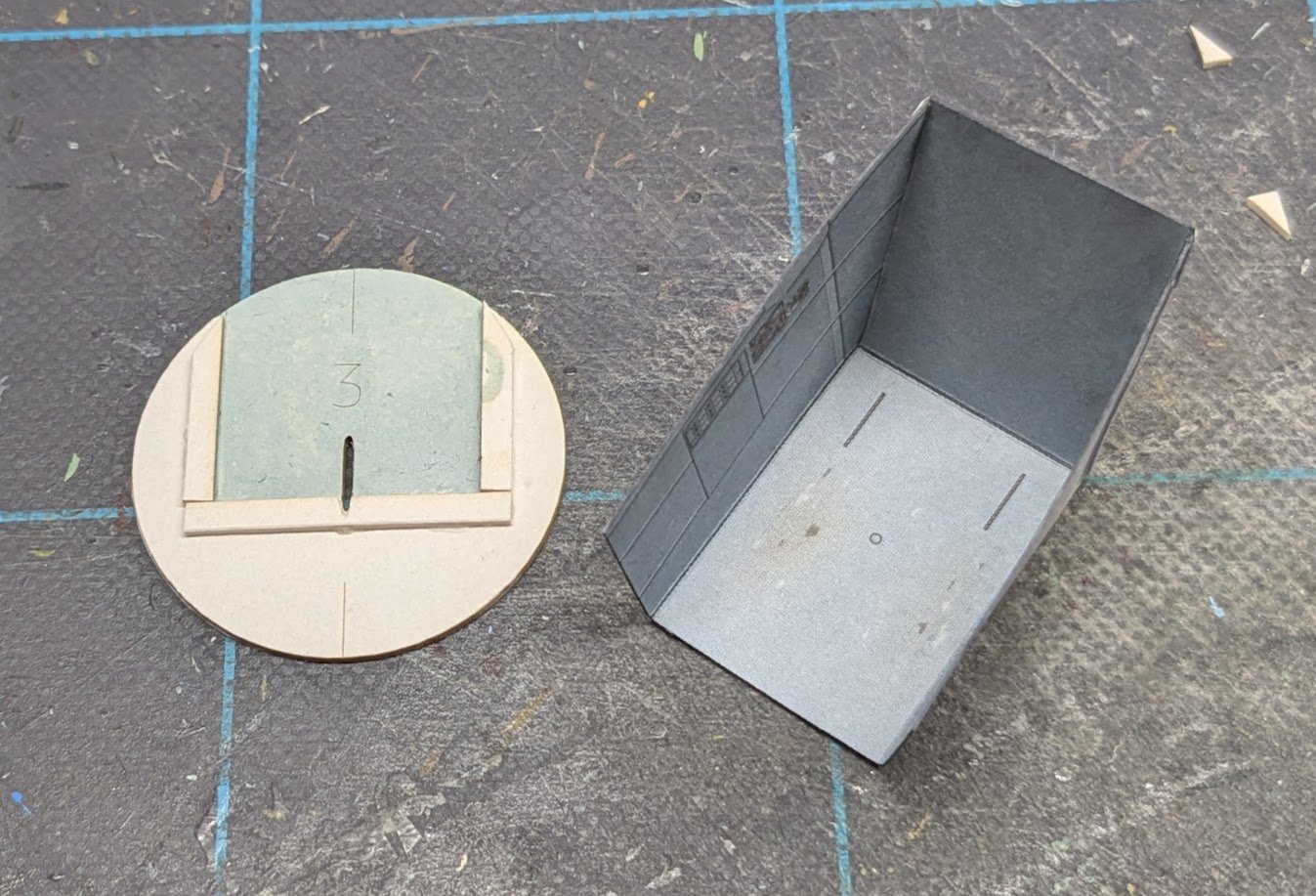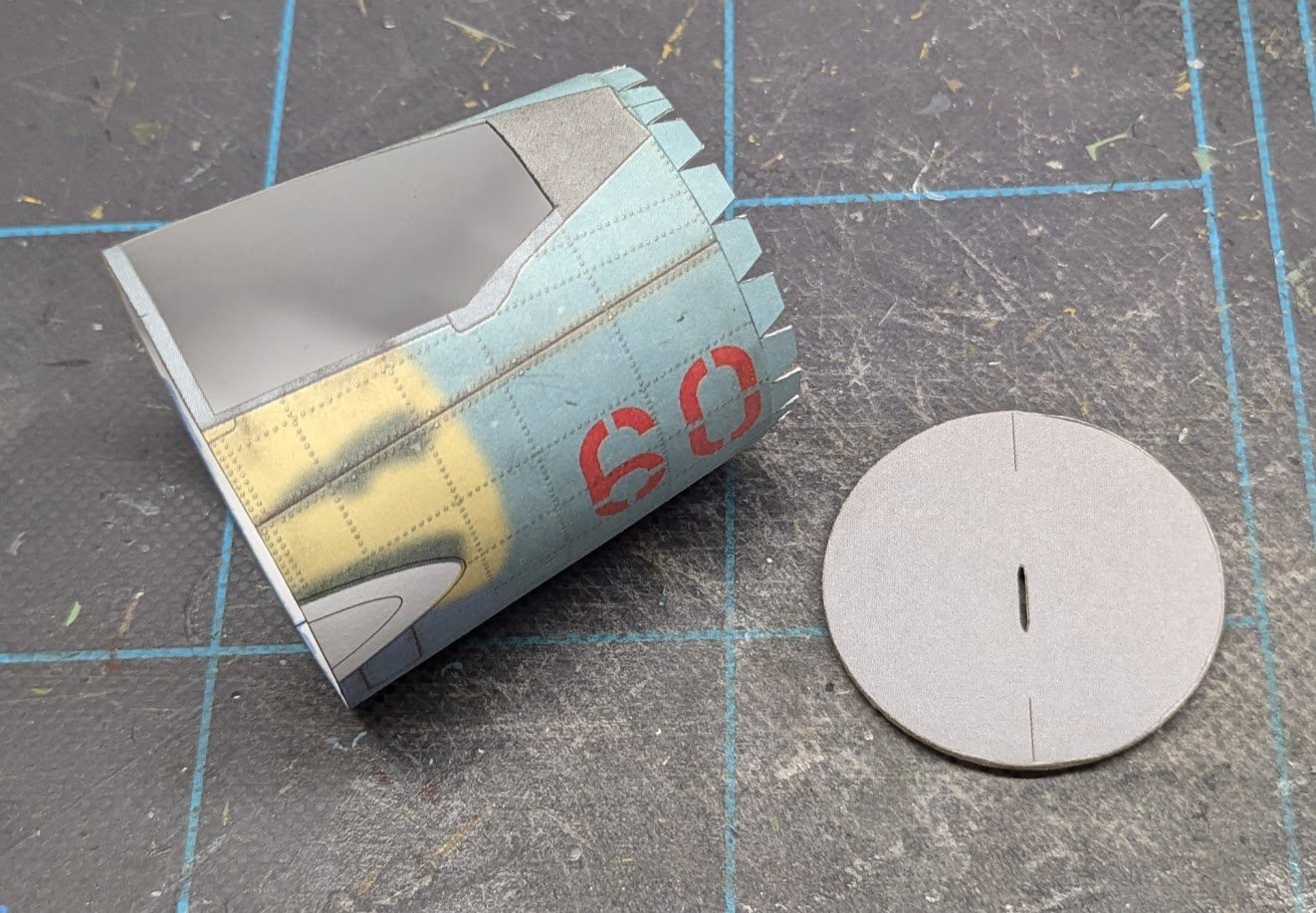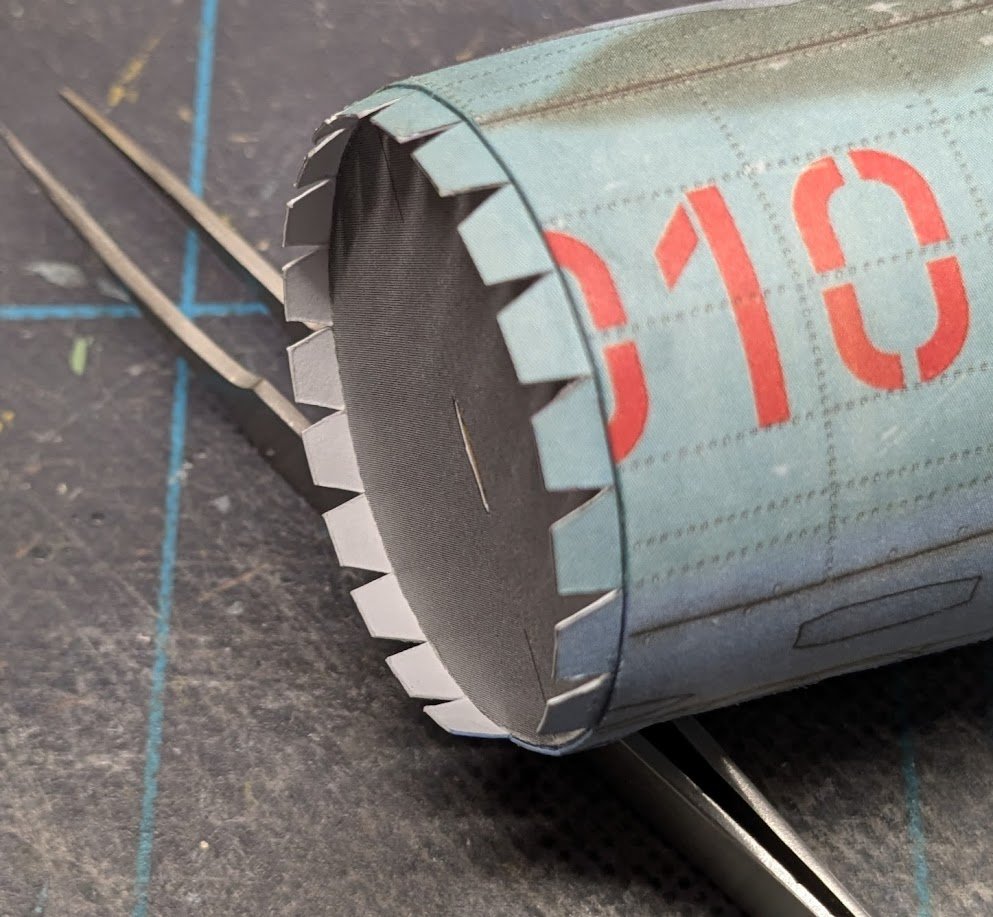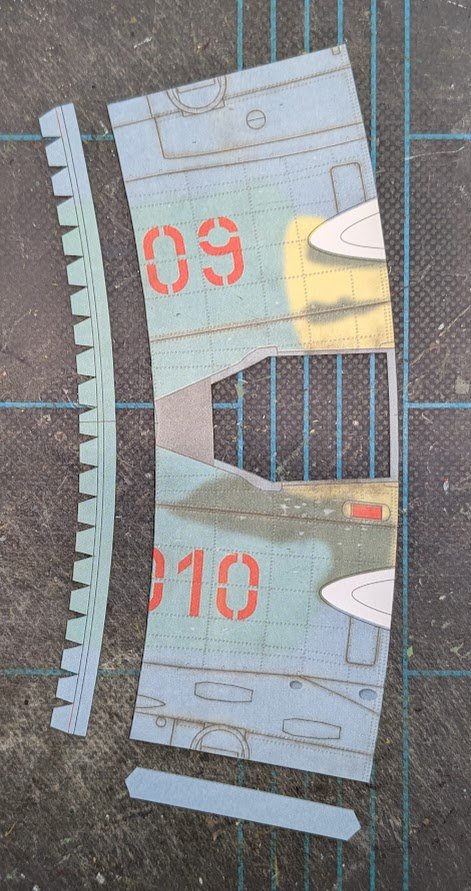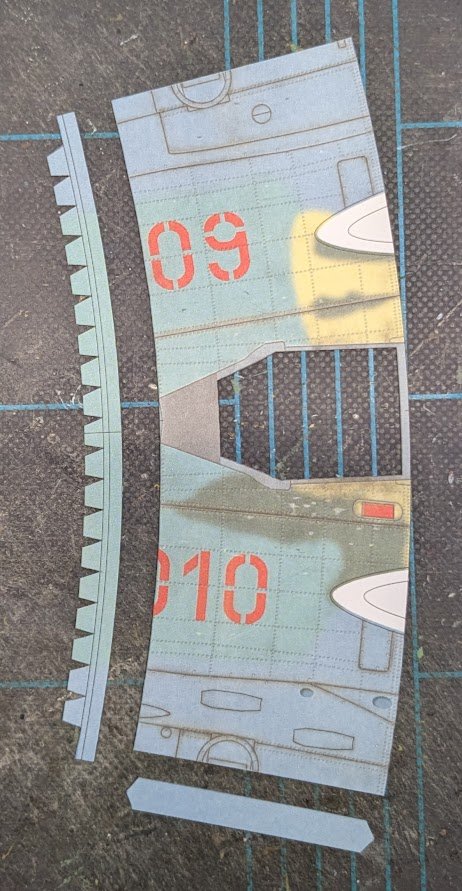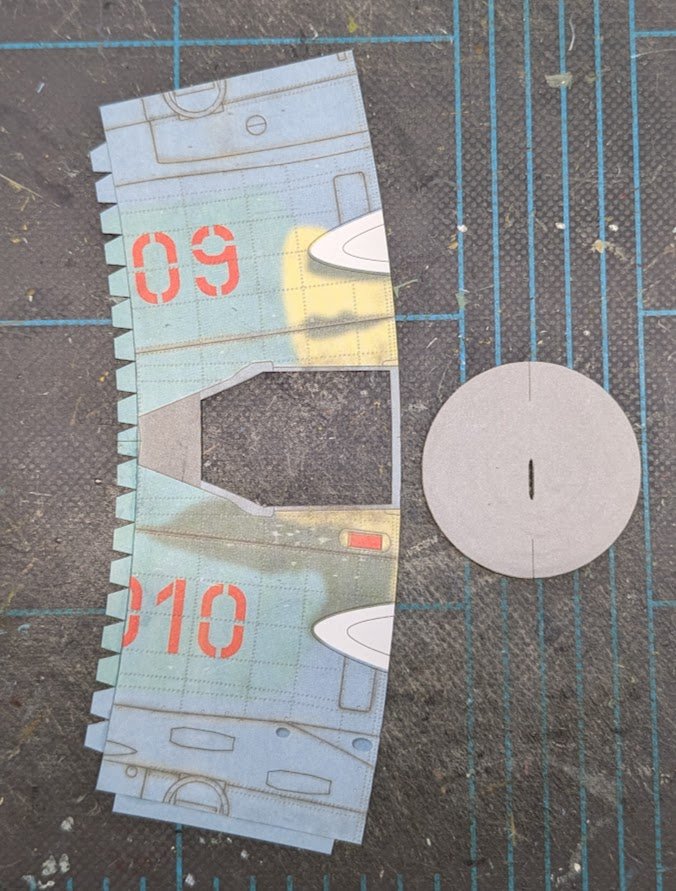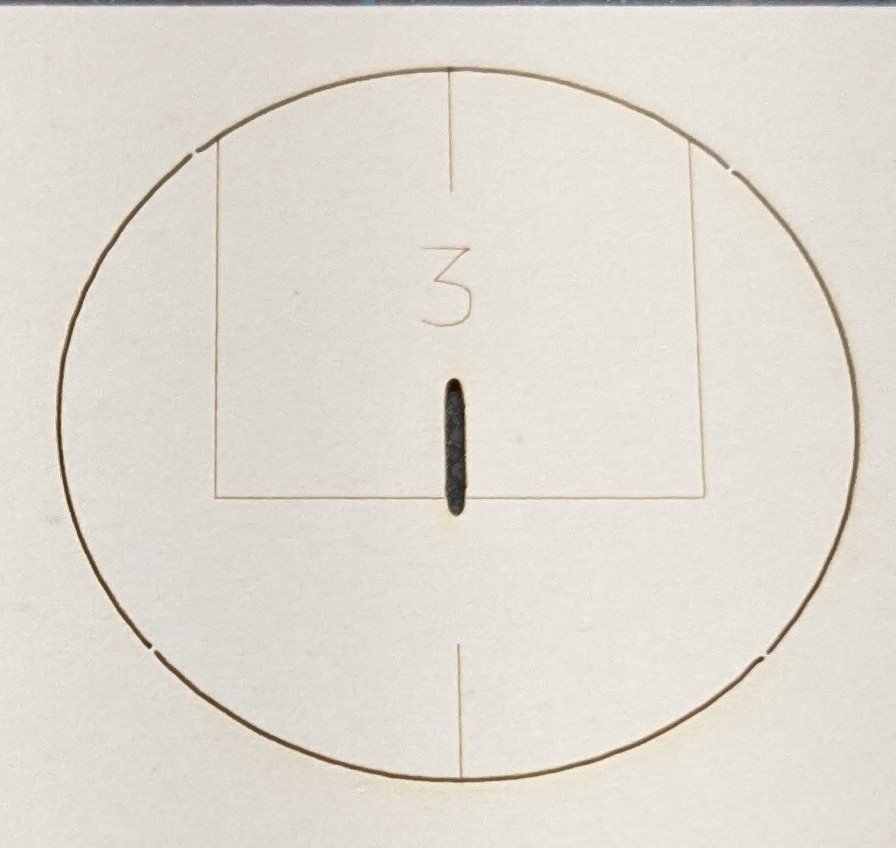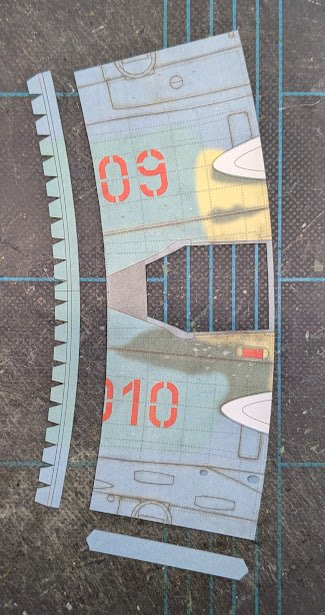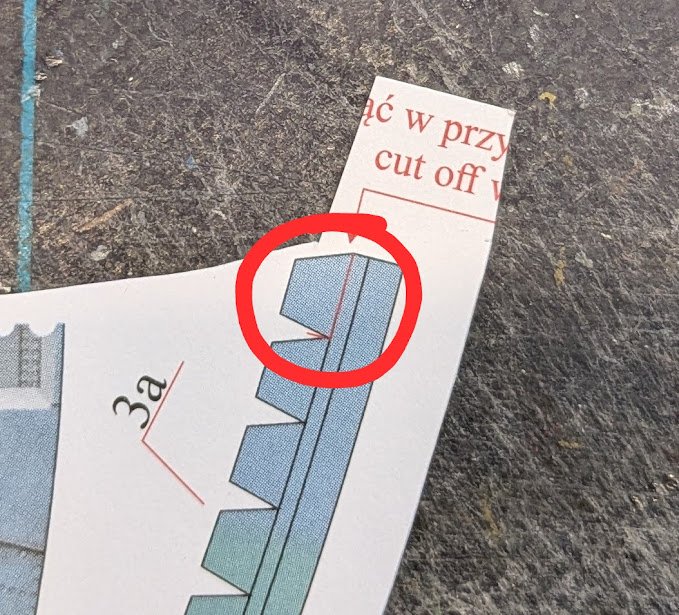-
Posts
10,307 -
Joined
-
Last visited
Content Type
Profiles
Forums
Gallery
Events
Everything posted by ccoyle
-
Now we get into one of the construction sequences that is affected by whether the builder opts for wheel wells. If you choose to omit wheel wells, the sequence is pretty straightforward -- just two more conic sections and a bulkhead. (NOTE: Regardless of option, weight must be added to the interior of the nose for the model to sit correctly on its tricycle gear.) If you decide to go for the wheel wells, well then things get a little dicier. First we fold and glue up the nose wheel well -- no biggie. I later added scrap card strips along its sides, as I did for the observer's tub. DO NOT add strips to the front or back -- the tub is designed to fit snugly between two bulkheads. Note that there is a small projection on the forward end of the well. Here we have the forward bulkhead with the faux air inlet laminated to it. The builder can either leave it like this or choose to add a more detailed inlet divider. The cutout at the bottom is only done for the wheel well option -- this is where the previously mentioned wheel well projection passes through the bulkhead. The next part could be a challenge. The first part of the detailed air inlet consists of a printed interior color ring that has to be wrapped in multiple paper rings. The challenge lies in getting the first ring perfectly round. Here's how I went about that. First, I needed to pre-shape the interior color ring. Happily, it fits perfectly around the handle of a 23mm dapping tool. The part was dampened, wrapped, taped, and allowed to dry. Note that the color side goes on the inside of the ring. Note that the ring parts are lettered b to f and that their lengths increase slightly with each part, because as each one is added, the diameter of the ring increases. Leaving the first ring on the dapping tool, I overlapped the seam with ring b to close the first ring. For each successive ring, I shifted the seam slightly so as not to create a weak point in the ring's structure. Here's the finished ring with some items to note. First, I wrapped the wrong end of the interior color cylinder. 😑 The wrapped rings should be at the front of the cylinder, and the little printed triangle on the interior ring points in that direction, hence my rings are on the back. Fortunately, this is only a minor error, but it's still annoying. Second, I did not add ring f; I noticed that each ring produced a widening gap at its seam, indicating some error creep, so on the very strong suspicion that the ring will be slightly too large even at this stage, I chose to leave the last ring off. Lastly, I soaked the outside of the ring with CA to stiffen the part. Finally, here's a group shot of all the parts that will go into making the nose of the aircraft: two conic sections, the wheel well, the inlet bulkhead, the inlet ring, and the parts to make the inlet divider. Unlike the previous fuselage sections, the larger ring here has no seam tab, since its two ends will land on the wheel well (hence the addition of the scrap card along the well's sides), and the smaller ring does not wrap around a bulkhead -- it will be glued to the joiner strip on the larger ring aft and to the interior air inlet ring forward. I suspect I may need to bevel the inlet ring to get things to fit easily. Fingers crossed!
-
Nice to hear the voice that goes with the models! It was fun hearing your hosts describe one or the other of your models and thinking, "Hey, I've seen that one!"
- 81 replies
-
- Micromaster
- Eduard
- (and 4 more)
-
Now we get to see that fuselage grow! The forward bulkhead of the observer's section has a color piece to be laminated to the laser-cut bulkhead. Here are all the parts and sub-assemblies for the observer's section. Both bulkheads have been beveled. We add the joiner strips, close the cylinder, and glue in the forward bulkhead. It's better, I think to glue the instrument panel to the bulkhead after the bulkhead is glued in -- adding the panel first would make it more difficult to glue in the bulkhead. I added some scrap 2mm card to the flimsy observer's tub to increase the gluing surface area. Once the tub is glued in, there's no way to reach into the fuselage to help position the aft bulkhead. To make the task easier I punched a couple of holes in the bulkhead and stiffened it with CA. The holes make it possible to manipulate the bulkhead with pliers. And here's the finished assembly. A little bit of muscle (but not too much) will be required to glue the two fuselage sections together, so it's a good idea to let the glue cure for awhile. That's it for now! And yes, if you're wondering, I did mow and edge my grass today and plan to de-thatch it this evening. Fun. 😑
-
Here are the parts for the two seats. Making the seats is not difficult. Matching the curve of the bottom to the two sides on each seat is a bit challenging, but not overly so. There is no reverse-side printing on the parts, so you will need to add some color to the front of each bucket. You can now see the different cant produced by the two sets of seat mounts -- the seat on the right with the steeper cant is the pilot's seat. The control stick has been added. The kit provides a paper part to be rolled, which is a pain for tiny, narrow tubes, so I replaced it with painted 0.88 mm styrene rod. All we needed to do next was glue the tub into the cockpit section and add the seat. BTW, there are locator marks for the seat on the cockpit floor, but they don't match the width of the seat mounts. They're useful, though, for centering the seat. Next we move to the observer's station, starting with his instrument panel. The panel consists of three pieces of 2 mm laser-cut card to be laminated together and then skinned. The construction is not difficult. And now for some bad news: We had our first hot day in the Upstate today. I had to turn the AC on for the first time this year to cool down my sweltering upstairs man cave (I really dislike summer weather). We also got a cubic yard of topper for the front lawn, so a lot of spring yard work is in the immediate forecast (I really dislike yard work). Hopefully I will still get some modeling time in. That's all for now!
-
A bit more progress. . . Next we have the rudder bar. There is a template for making the bar from wire. Don't worry about matching the template exactly -- this element will be difficult to see in the finished model. In fact, the instructions even suggest omitting the rudder bar if you don't want to deal with it. Here's the finished rudder bar mounted to the cockpit floor. The bar is fiddly -- there's no magic bullet for coping with the tiny parts. Maybe keep a swear jar handy?🤔 Also, there's no locator mark on the floor, but the bar is supposed to be positioned directly below the instrument panel. Next we will start on the seats, remembering that the pilot's seat doesn't go into the cockpit tub until later. Here's a bunch of seat parts that need to be doubled, i.e., folded and glued to make a 2x-thick part. The instructions say that the two seats are identical, but there is obviously two different sets of parts #11. I suspect the difference is linked to slope of the floor in each tub, but I will need to confirm this once both tubs are ready for seats. There's also a bunch of seat cushions that must be laminated to laser-cut backings. That's it for tonight. Time permitting, I'll get the seats assembled tomorrow.
-
Being an intermediate-level kit, only rudimentary cockpit details are included. Here is the instrument panel laminated to its laser-cut backing and edge colored. No option for glazing is included, but it could be done by using a photocopy of this part. I have depicted glazing in some of my other logs. And here is the panel glued into the cockpit. You might be able to see where I added a center line tic mark on the fuselage skin to help position the panel correctly. The next numbered part is the gun sight. I suggest holding off on that part, because it sits on top of the cockpit dash, which means it might get bumped a lot during the fuselage construction. I have circled this part on the construction diagram to remind myself to add it later. Next we'll work on the bits that go into the cockpit tub.
-
One thing I have learned over two decades of building card models is that it pays to study and re-study the diagrams. The part I mentioned in post #12 is not a false air inlet -- it's the interior nose wheel well color. Also, I noticed that the pilot's seat protrudes above the level of the fuselage, so it can't be glued into the cockpit tub until after the tub is in the fuselage. Here's a couple of simple modifications I made to the bulkhead before proceeding. First, I don't know how much of that bulkhead will be visible on the finished model, so to be safe I added some interior color to it. It's not an exact match for the cockpit tub, but at least it's not pulp board colored. Second, I added some scrap card along the lines that indicate where the tub is to be glued. This will make neater and stronger joints between the tub and bulkhead. Here's the fuselage section glued into a ring. Try to get the ring as round as possible -- it will make fitting the bulkhead easier, and the ring will be more difficult to shape once the bulkhead is in. A couple of tips on the bulkhead. Notice that the fuselage section isn't a true cylinder -- it's a conic section. Beveling the edge of the bulkhead will make it easier to fit and enable it to make better contact with the fuselage skin. Only a slight bevel is needed, so don't go overboard. If you want, you can soak some thin CA into the bulkhead to stiffen it. With the joiner strip in place, it can be difficult to align the bulkhead properly, unless you were careful in aligning the joiner strip to the fuselage piece first. If you were careful, then gluing the bulkhead flush with the ends of the darts cut into the joiner strip will also make the bulkhead flush with the cylinder opening. You can see here that the dart tips just touch both the fuselage skin and the interior bulkhead. Tip: With a large bulkhead like this one and any type of fast-setting glue (such as canopy glue), you may not have time to adjust the part if you apply glue to the entire rim of the bulkhead first and then try to position it within the cylinder (or vice versa). What I do in such instances is position the dry bulkhead first, then run a bead of glue around the interior seam -- like caulking a tub. That's it for this session!
-

Vanguard's cutter kits....how do they differ?
ccoyle replied to bigcreekdad's topic in Wood ship model kits
When you say "JoTiKa version" versus "Vanguard Models version", you're really comparing an early Chris Watton design with a much more recent Chris Watton design. -

Vanguard's cutter kits....how do they differ?
ccoyle replied to bigcreekdad's topic in Wood ship model kits
Which cutters are you referring to, the ships' boats or the larger kits such as Alert and Trial? -
This is all I had time for last night. In this progression, we see first the fuselage parts with the joiner strip as it should be used for the no-wheel-wells option, the parts with the joiner trimmed for wheel wells (nose wheel, in this case), and the prepped fuselage section with its bulkhead, which consists of a laser-cut frame and printed part laminated together. Some thought had to be given to the bulkhead. As I mentioned earlier, the frames are laser-engraved, as seen here. It took me awhile to realize that the printed part is not the interior cabin color, but rather a kind of false air inlet that will be seen from the front of the finished model. Therefore, the part needs to be glued to the back of the printed bulkhead, making sure the two oval-shaped holes align properly -- they are not centered. That's it for now!
-
Welcome aboard!
-
The instructions call for the first section of fuselage to be be built next. Here is the section and its joiner strips. But before we can move on, we need @CDW and @Richard44 to make a decision: wheel wells or no wheel wells? If the former, then we will need to remove part of the joiner strip before gluing it to the fuselage piece, as indicated here:
-

The Mossy Shipyard by Bryan Woods - 1:1
ccoyle replied to Bryan Woods's topic in Non-ship/categorised builds
Looks to me like with a minimum of modification, your shipyard could double as a permanent deer stand. 🤔 -
This is totally on Model Shipways, not on Midwest, since MS now does the manufacturing. The Midwest-version smack was my first wooden ship model, and I don't recall any metal cleats in the kit. Off-the-shelf fittings are one of the unfortunate cost-cutting compromises found in kits. The correct term is Britannia metal (also called white metal), which is a specific type of pewter, but yeah, it is still awful to work with. It came into use as a placement for lead fittings, which would oxidize over time, causing a phenomenon known as "lead disease" (not to be confused with lead poisoning). Keep up the good work!
- 34 replies
-
- muscongus bay lobster smack
- Model Shipways
-
(and 1 more)
Tagged with:
About us
Modelshipworld - Advancing Ship Modeling through Research
SSL Secured
Your security is important for us so this Website is SSL-Secured
NRG Mailing Address
Nautical Research Guild
237 South Lincoln Street
Westmont IL, 60559-1917
Model Ship World ® and the MSW logo are Registered Trademarks, and belong to the Nautical Research Guild (United States Patent and Trademark Office: No. 6,929,264 & No. 6,929,274, registered Dec. 20, 2022)
Helpful Links
About the NRG
If you enjoy building ship models that are historically accurate as well as beautiful, then The Nautical Research Guild (NRG) is just right for you.
The Guild is a non-profit educational organization whose mission is to “Advance Ship Modeling Through Research”. We provide support to our members in their efforts to raise the quality of their model ships.
The Nautical Research Guild has published our world-renowned quarterly magazine, The Nautical Research Journal, since 1955. The pages of the Journal are full of articles by accomplished ship modelers who show you how they create those exquisite details on their models, and by maritime historians who show you the correct details to build. The Journal is available in both print and digital editions. Go to the NRG web site (www.thenrg.org) to download a complimentary digital copy of the Journal. The NRG also publishes plan sets, books and compilations of back issues of the Journal and the former Ships in Scale and Model Ship Builder magazines.

